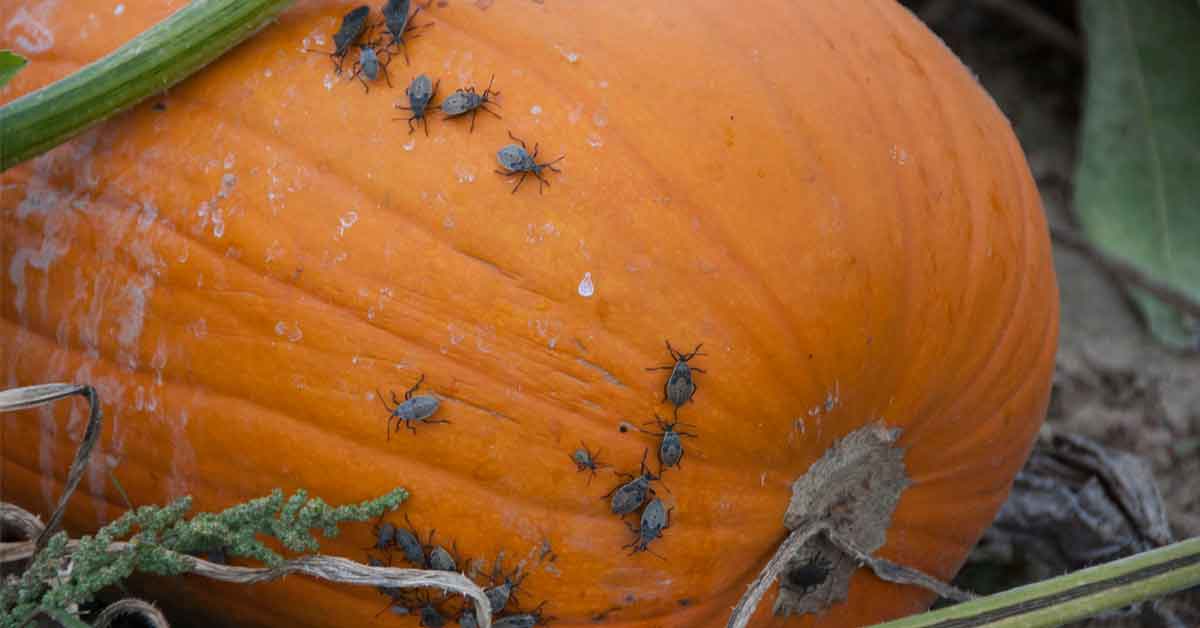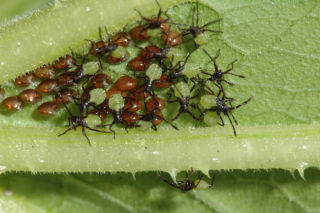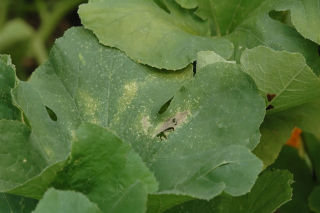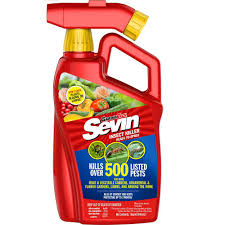Ultimate Squash Bug Trap

Squash bugs are a problem for anyone growing pumpkins, melons, or even cucumber. It is terrible to go out to your garden and see these sneaking pests, hiding behind the ridges of your prized pumpkins or the brown leave patches they create. Unfortunately, squash bugs or Anasa tristis thrive in dry and hot areas which, with global warming, is an ever expanding zone. Adult squash bugs are 1.4-1.5 cm in length with dark grayish brown or black coloring. Along the abdomen and over the back are gold or brownish spots that sometimes look like eyes to would be predators. Adults live 75 to 130 days depending on the availability of food. There are many different types of these bugs and they each prefer a different type of melon.
During their life, the nymphs go through several molts and emerge into the adult squash bugs which are very difficult to control since they hide from gardeners. A gardener must visit their garden daily to inspect the plant leaves for squash bug infestation. The nymphs are the target since they are easiest to control.
Life Cycle
The complete life cycle of the squash bug commonly requires six to eight weeks. Squash bugs have one generation per year in northern climates and two to three generations per year in warmer regions. The early-emerging adults, from the first generation, produce a second generation, whereas the late-emerging adults, go into a period of suspended development. Both sexes overwinter as adults. The preferred overwintering site seems to be in melon fields under crop debris, clods of soil, or stones, but adjacent wood piles or buildings are favorite wintering spots. Keeping the garden and adjacent areas clean is a must to help prevent infestation.

Squash Bug Eggs
Squashbug eggs are laid on the under surface of leaves, though they are sometimes found on the upper surface or on the junction of leaf and stem. The elliptical egg is somewhat flattened and bronze in color. The average egg length is about 1.5 mm and the width about 1.1 mm. Females lay about 20 eggs in each egg cluster. You might find eggs tightly clustered or spread a considerable distance apart, but an equidistant spacing arrangement is normal. The egg stage lasts about seven to nine days.

Young Squash Bugs
There are five development stages for squash bug nymphs. Once the eggs hatch, the nymph stage requires about 33 days for complete development so there is time for an vigilant gardener to control this pest. The nymph is about 2.5 mm in length when it hatches and a light green in color. In the second stage, the nymph is initially about 3 mm long with a light gray color. These nymphs typically bunch together. In the third, fourth, and fifth stages, the nymphs are about 4mm, 6 to 7mm, and 9 to 10 mm in length; respectively, turning dark gray.
The youngest nymphs are rather hairy, but this decreases with each subsequent molt. In contrast, the thorax and wing pads are barely noticeable when eggs hatch, but get more pronounced as the nymphs mature. Young nymphs are strongly gregarious and pack together, a behavior that dissipates slightly as the nymphs get older. This pack mentality helps gardeners easily eliminate young squash bugs.
Squash Bug’s Favorite Snack
Squash bugs enjoy all types of cucurbits (melons) but they especially like pumpkin and squash. If you plant any kind of cucurbit, you would be advised to keep a daily eye on the leaves of your. otherwise, healthy plants. Studies in the USA have shown that different types of squash bugs like different varieties of melon. When studied nymphs were reared to the adult stage their survival rates were highest in the order of pumpkin, squash, watermelon, cucumber, and muskmelon (cantaloupe), respectively. However, squash bugs are adaptable, so if they only have access to one type, say cantaloupe, they could adapt well if left unchecked.

Pest Damage
Squash Bug’s saliva is highly toxic to the plant. This is how to detect an infestation since the area where squash bugs feed shows in yellow patches, then brown spots, and finally withered leaves. In addition, some bugs carry disease bacteria that they transmit to the plants while sucking their favorite sap or attacking the fruit of the plant. The foliage will wilt, turn brown then eventually blacken. Nearby plants may appear healthy but the portion of a plant where the squash bugs are feeding will die. Therefore it is important to be vigilant when you see brown spots appearing on any leaves.
Pest Controls
Natural Enemies
A wasp parasite injects its eggs in to into some of the squash bug’s egg clusters. These wasp larva feed on the nymphs when they emerge. And another brightly colored fly uses squash bug adults as hosts. This was verified when 20% of the adults studied in the USA were parasitic hosts. The flies, over time, would emerge from female squash bugs, killing the hosts. However, squash bugs emit a strong noxious smell when smashed which also gives them the erroneous label of “Stink Bugs”. A bug which is actually rounder in shape than the squash bug. Therefore, these pests are not eaten by many other insect eating predators, such as birds, lizards, or bigger bugs.
Insecticides

Squash Bugs are difficult to kill with insecticides and spraying insecticides when plants are in bloom can affect beneficial pollinators like bees or the wasps that are their natural enemy. If you use chemical sprays, make sure to do it either early in the morning or late in the evening. While, the use of pesticides is the most effective way for bug eradication on large farms, it is not the healthiest or best way for the environment. There are effective ways to get rid of these pests without using chemicals unless you already have a large infestation of bugs. If so, one of the most effective powders is called Sevin. It should be used according to the manufacturer’s suggestions while avoiding any flowers that might attract beneficial insects.
Protection Against Squash Bugs at Home
To maintain your garden, bug free, you need to make sure your plants are kept as healthy as possible with proper water and fertilization. Check your soil PH levels since the proper PH Level assists plants in getting nutrients from the soil. As long as plants are not stressed and the farmer keeps an eye on plants regularly, the Squash Bug infestation is easily controlled.
- Early detection of nymphs is critical because adult bugs are difficult to kill.
- Routinely, remove nymphs, eggs, and any adult — see how below.
- Afterwards, wash the leaves with soapy water.
- Adults will hurry to hide under leaves and are difficult to find, however, at night they like to congregate under wood or newspaper. Put some down between rows and collect the adults early in the morning.
- Remove any newspapers or wilted/dead plant debris that are in the rows so the adults do not have hiding places.
- At the end of harvest, collect all dead plants, especially squash vines and remove to the compost bin, then turn the vines under in a hot pile.
- Practice crop rotation.
- Do not mulch beneath squash plants with straw or coarse material as this gives the pests places to hide. Pull on gloves and hand weed this section of the garden.
- Companion planting between each squash plants with nasturtium or tansy will help control the pests.
- Finally, planting ‘Butternut’, ‘Royal Acorn’, and ‘Sweet Cheese’ are all varieties that are more resistant to squash bugs.
The Ultimate Squash Bug Trap
To trap the young squash bugs, you need to buy some painters’ tape. Duct tape will work but may stick too aggressively to the leaves. Blue painters tape is best. Wrap the tape around your palm with the sticky side out. Where you see the young nymphs, press the tape on top of the nymphs. They will come away with the tape. Then fold the tape over on the bugs and they are trapped. You can “squash” them if you want to make sure they are dead or burn the tape.
Squash Bug Control
Strong, healthy plants are the best defense against these bugs. But farmers must inspect the large leaves of healthy plants for signs of eggs or nymphs. Washing away or using sticky tape on an early infestation will help you to enjoy the fruit of your labor. You can enjoy your big, bug free, pumpkins, squash, and watermelon.
I hope you enjoy your harvests and that you have plenty of pumpkins to set outside come October. Let me know in the comments below if you have had trouble with squash bugs. As noted, these pests are often mistaken for stink bugs, as they are similar in appearance and both have a foul odor when squashed. However, stink bugs are wider and rounder than squash bugs. I grew up with both stink bugs and squash bugs — my brother threw them on me. Don’t feel sorry for me, I probably deserved it, for some other misdeed that I instigated. :0) Thank you for reading my blogs, I know your time is valuable and I appreciate it.